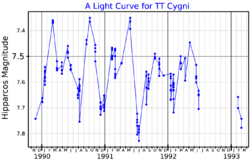TT Cygni
Topic: Astronomy
 From HandWiki - Reading time: 3 min
From HandWiki - Reading time: 3 min
| Observation data Equinox J2000.0]] (ICRS) | |
|---|---|
| Constellation | Cygnus |
| Right ascension | 19h 40m 57.01599s[2] |
| Declination | +32° 37′ 05.7555″[2] |
| Apparent magnitude (V) | 7.26 - 8.0[3] |
| Characteristics | |
| Evolutionary stage | AGB |
| Spectral type | C5,4e(N3e)[3] |
| B−V color index | +2.917±0.073[4] |
| Variable type | SRb[5] |
| Astrometry | |
| Radial velocity (Rv) | −49.0±3.1[4] km/s |
| Proper motion (μ) | RA: −5.178[2] mas/yr Dec.: −1.832[2] mas/yr |
| Parallax (π) | 1.4908 ± 0.0368[2] mas |
| Distance | 2,190 ± 50 ly (670 ± 20 pc) |
| Absolute magnitude (MV) | −1.297 (var.)[6] |
| Details | |
| Radius | 166[7] R☉ |
| Luminosity | 2,735[8] L☉ |
| Surface gravity (log g) | −0.4[8] cgs |
| Temperature | 3,200[8] K |
| Other designations | |
| Database references | |
| SIMBAD | data |
TT Cygni is a carbon star located 561 parsecs (1,830 ly) away in the northern constellation of Cygnus. It is classified as a semiregular variable of subtype SRb that ranges in brightness from magnitude 7.26 down to 8.0 with a period of 118 days.[3] This object is called a carbon star because it has a high ratio of carbon to oxygen in its surface layers. The carbon was produced by helium fusion, dredged up from inside the star by deep convection triggered by a flash from the helium shell.
A thin spherical shell around the star, about half a light year across, was emitted 7,000 years ago.[10] It was first detected from its carbon monoxide emission and has a mass around four thousandths M☉, of which about a tenth is dust. The dust is thought to be mostly amorphous carbon.[8]
References
- ↑ "Hipparcos Tools Interactive Data Access". ESA. https://www.cosmos.esa.int/web/hipparcos/interactive-data-access.
- ↑ 2.0 2.1 2.2 2.3 2.4 Brown, A. G. A. (August 2018). "Gaia Data Release 2: Summary of the contents and survey properties". Astronomy & Astrophysics 616: A1. doi:10.1051/0004-6361/201833051. Bibcode: 2018A&A...616A...1G. Gaia DR2 record for this source at VizieR.
- ↑ 3.0 3.1 3.2 TT Cygni, AAVSO, https://www.aavso.org/vsx/index.php?view=detail.top&oid=10947, retrieved 2021-02-04.
- ↑ 4.0 4.1 Anderson, E.; Francis, Ch. (2012), "XHIP: An extended hipparcos compilation", Astronomy Letters 38 (5): 331, doi:10.1134/S1063773712050015, Bibcode: 2012AstL...38..331A.
- ↑ Samus, N. N. et al. (2017), "General Catalogue of Variable Stars", Astronomy Reports, 5.1 61 (1): 80–88, doi:10.1134/S1063772917010085, Bibcode: 2017ARep...61...80S.
- ↑ Gontcharov, G. A. (2011), "The red giant branch in the Tycho-2 catalogue", Astronomy Letters 37 (10): 707–717, doi:10.1134/S1063773711090040, Bibcode: 2011AstL...37..707G.
- ↑ McDonald, I.; Zijlstra, A. A.; Watson, R. A. (2017), "Fundamental parameters and infrared excesses of Tycho–Gaia stars", Monthly Notices of the Royal Astronomical Society 471 (1): 770–791, doi:10.1093/mnras/stx1433, Bibcode: 2017MNRAS.471..770M.
- ↑ 8.0 8.1 8.2 8.3 Groenewegen, M. A. T. (2012), "An extension of the DUSTY radiative transfer code and an application to OH 26.5 and TT Cygni", Astronomy and Astrophysics 543: A36, doi:10.1051/0004-6361/201218965, Bibcode: 2012A&A...543A..36G.
- ↑ "TT Cyg". SIMBAD. Centre de données astronomiques de Strasbourg. http://simbad.u-strasbg.fr/simbad/sim-basic?Ident=TT+Cyg.
- ↑ Olofsson, H. et al. (January 2000), "A high-resolution study of episodic mass loss from the carbon star TT Cygni", Astronomy and Astrophysics 353: 583–597, Bibcode: 2000A&A...353..583O.
 |
 KSF
KSF
